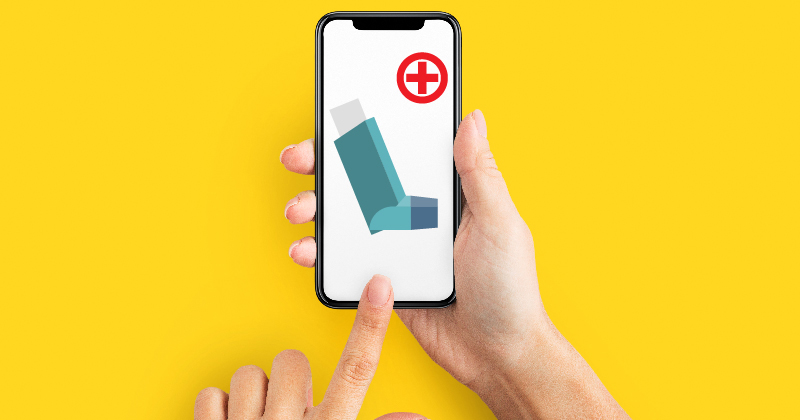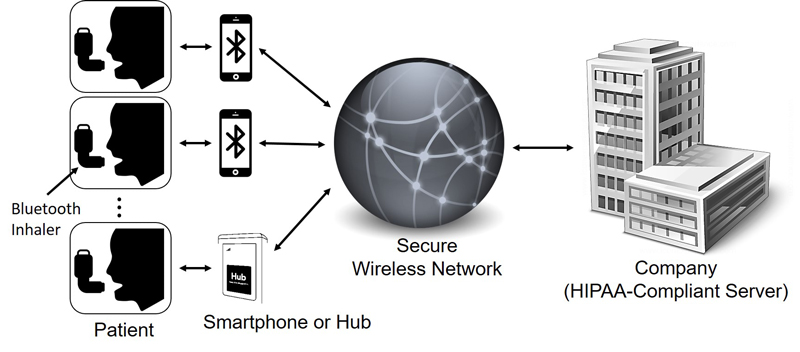


Treating asthma with data analytics
Illustration by Julie Morin, diagram courtesy of Junbo Son March 09, 2020
Research from UD’s Junbo Son could transform the future of asthma management
As more and more people incorporate Internet of Things (IoT) devices into their lives, users are automating their homes, their vehicles and their workplaces. New research from the University of Delaware’s Junbo Son suggests that IoT devices could have another impactful use: managing chronic health conditions and even saving lives.
Son’s research, published in MIS Quarterly, created a health information system that helps asthma patients to better self-manage their condition using Bluetooth-enabled inhalers and a special data analytics algorithm. This could make a big difference for the almost 25 million asthmatic people in the United States.
“Our analytics framework has great potential for transforming the current practice of asthma management, especially considering the growing popularity of wearable sensors and IoT devices in the healthcare domain,” said Son, who is an assistant professor of operations management at UD’s Alfred Lerner College of Business and Economics. “To truly realize the vision of IT-enabled smart healthcare, algorithmic development for managing, analyzing and visualizing health data is crucial.
“As a data scientist, I found myself very interested in this research topic because the data collected by those unprecedented IT devices such as IoT medical devices and wearable sensors present a significant research opportunity,” he said. “Of course, they bring a set of new challenges as well. But, to me, that is the fun part of working with cutting-edge technology.”
Son co-wrote the article “Data Analytics Framework for Smart Asthma Management Based on Remote Health Information Systems with Bluetooth-Enabled Personal Inhalers” with the University of Wisconsin-Madison’s Shiyu Zhou as well as UD nursing alumna Patricia Flatley Brennan, who serves as the director of the National Library of Medicine. The interdisciplinary nature of this project, Son said, makes its findings particularly valuable.

“It is absolutely an exciting time for interdisciplinary research projects and, collectively, we can make a positive impact,” he said. “I hope this work my co-authors and I have done recently took a step closer to achieving better healthcare practice by utilizing IT and, hopefully, attracted a bit more attention to this important topic.”
The team’s Smart Asthma Management (SAM) system works by collecting a timestamp of a patient’s every inhaler use through a Bluetooth sensor that is attachable to various types of personal inhalers. The sensor transmits inhaler usage data to the patient’s smartphone and eventually to a server via a secure wireless network, where the data goes through the SAM algorithm. The algorithm is unique, Son explained, because it was designed especially for the specific clinical features of asthma.
“For instance, nocturnal inhaler usage is typically considered more seriously than inhaler uses during daytime in asthma management,” he said. “In addition, there are some common characteristics across all asthma patients but, at the same time, the algorithm needs to note that each individual patient is different.”

These individual differences include demographics and each patient’s sensitivity to environmental asthma triggers like air pollution or temperature. It also has to take into account each patient’s unique daily routine. For example, if a patient exercises around 8:00 p.m. every day, that inevitably affects their inhaler use.
The team’s results found that their method outperforms the current models popularly used in recent clinical studies. The SAM system has a false alarm rate 10-20% lower than current models, and a 40-50% lower misdetection rate. It also has a 10-30% higher “area under the curve” score, a widely accepted performance metric for classification algorithms.
“These results highlight the importance of tailor-made data analytics methods, especially in the healthcare domain,” Son said. “In other words, an analytics tool should be carefully designed to accommodate the needs of personalization (all patients are different) and specialization (each disease has its unique characteristics).”
Results like these also mean that the SAM system has a better chance of detecting dangerous increases in inhaler usage more quickly than patients can identify them. As Son explained, while an asthma patient will typically know if they have been using an inhaler too often, a trend-focused and data-driven system can identify a more subtle trend even faster.
“Often it is too late when the patient can feel the exacerbated asthma symptoms,” he said. “If the SAM system coupled with the data analytics method can provide a timely warning, we can help asthma patients significantly.”
The system also goes beyond increased usage to help patients understand what might be making their asthma symptoms worse. Since the model includes information from patients whose demographic features and asthma severity are similar to the target patient, as well as data on environmental factors, it helps patients to identify new asthma triggers that they may have not noticed in the past.
The team is now in the next steps of working with an industry collaborator, a company that has developed the SAM system along with a smartphone app and web-based dashboard. This company is also implementing and testing the team’s algorithms to improve their asthma care service. There are several challenges ahead, including working with insurers and medical practitioners, creating cost sharing strategies and studying potential legal issues, but Son is enthusiastic about the future of this project and others like it.
“We believe that work like this needs to be done more by many experts in diverse areas,” Son said. “New infrastructure like the SAM system opens up a big window of opportunity showing us a great potential for improving the patients’ quality of life by collecting data that have not been typically available in the past.
“This is a revolutionary time for healthcare. The current practice of healthcare has been rapidly evolving due to the increased penetration of IT to the healthcare sector. I am just happy to be a part of the paradigm-shifting revolution.”
Contact Us
Have a UDaily story idea?
Contact us at ocm@udel.edu
Members of the press
Contact us at 302-831-NEWS or visit the Media Relations website

